- Index
- Chronology
- Neighborhoods
- Portfolio
- Ralph Haver
- Commercial
- Customs
- Characteristics
- Family Story
- Jimmie Nunn
- Civic Spaces
- Awards
- James Salter
- Multifamily
- Have a Haver?
Jazz Standard
Architect Shawn Kaffer improvises with a Phoenix icon
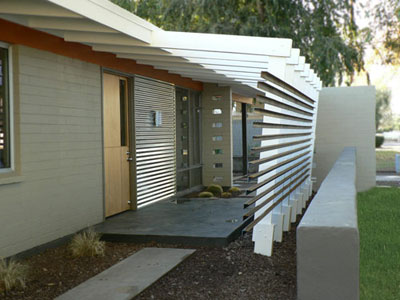 Story and Photography By Alison King.
A variation of this article was published in the April issue of Desert
Living Magazine.
Story and Photography By Alison King.
A variation of this article was published in the April issue of Desert
Living Magazine.
Midcentury era tract homes in Scottsdale and Phoenix are so ubiquitous that they often pass under the daily radar, and for good reason; classic ranch homes paved the suburbs of the Phoenix Metro area, emulating the romance of ranch style living in this citrus-field-gone-cosmopolitan city. During the same development boom that brought us western-themed ranches and whimsical character ranch styles such as Swiss Chalet and Dutch Colonial, there emerged a desert-adapted style of Contemporary Ranch architecture that passed on nostalgic forms in favor of neat lines and shade-soaked spaces.
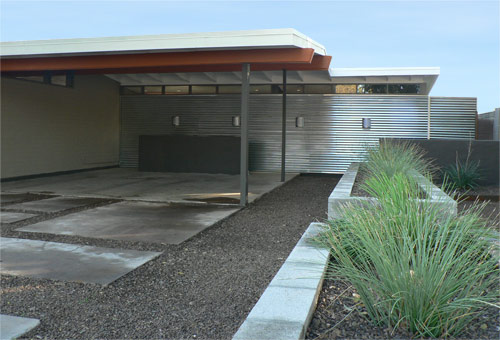 Few postwar architects in Arizona can match the volume of production, variety and notoriety than that of Ralph Haver. Californian by birth but Phoenician by choice, Haver offered his accessible contemporary style to thousands by collaborating with local developers on sizable tracts of land. In the postwar era, tinkering with this new style of home became the American family’s leisure-time hobby—their imaginations were fueled by a new genre of home-improvement publications such as Popular Mechanics and Sunset magazine.
Few postwar architects in Arizona can match the volume of production, variety and notoriety than that of Ralph Haver. Californian by birth but Phoenician by choice, Haver offered his accessible contemporary style to thousands by collaborating with local developers on sizable tracts of land. In the postwar era, tinkering with this new style of home became the American family’s leisure-time hobby—their imaginations were fueled by a new genre of home-improvement publications such as Popular Mechanics and Sunset magazine.
Today, Haver Homes are sought as creative projects for professional architects and do-it-yourselfers alike. Their clean lines, inherent potential for expansion and solid construction have allowed them to endure the decades through every possible design trend, from skimming with stucco to Santa Fe styling. Now Haver Homes are more likely to be stripped down to bare block or clad in corrugated steel to offer additional protection from the sun.
There was little intended as precious in Haver tract homes. Expression of economy and a few signature elements define the Haver Home styles. Preservationists generally agree that these homes retain their character better as one-story structures and that certain hallmark qualities, such as the clinker bricks and clerestory windows seen in several Haver neighborhoods are best left unmolested. But simply put, the tract homes were designed to be modified, including smooth concrete patios that were often destined to become Arizona Rooms, and the carports that could easily transform into a third bedroom to support a growing nuclear family. This inherently mutable trait poses a challenge among today’s designers who appreciate the original forms but invoke an oath to guide their work: Do nothing that cannot be undone.
In this regard, Haver Homes have become one of the Jazz Standards of architecture—a set of simple themes that an artist can improvise around while maintaining general integrity, and in the best cases emotionally thrill those it takes deep inside.

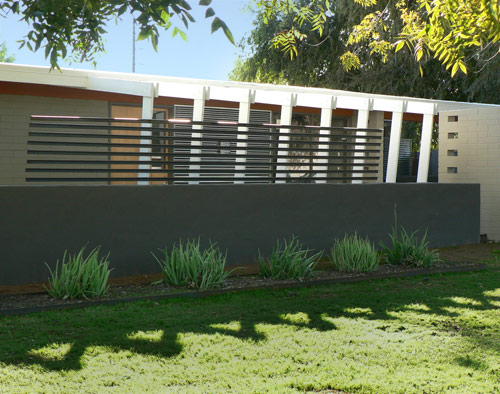 The Lorna House, built in 1954 in the Starlite Vista subdivision of Northwest Phoenix and named after the home’s former owner of 40 years, is one such dynamic environment. Tucked in a quiet neighborhood among larger lots with geese, goats, horses, and even llamas heralding Phoenix’s rural past, Shawn and Christine Kaffer’s improvisation on a classic Haver Home has been taken to playful heights.
The Lorna House, built in 1954 in the Starlite Vista subdivision of Northwest Phoenix and named after the home’s former owner of 40 years, is one such dynamic environment. Tucked in a quiet neighborhood among larger lots with geese, goats, horses, and even llamas heralding Phoenix’s rural past, Shawn and Christine Kaffer’s improvisation on a classic Haver Home has been taken to playful heights.
“When we found the house it was not in the Haver style or Modern style, and so the big challenge was to take what Lorna had done and make it cohesive with other renovations and rehabilitations of Haver Homes in Phoenix,” Shawn Kaffer explained.
Wherever possible, the horizontal elements of their home’s low-slung profile have been extended and emphasized. Simple solutions such as galvanized steel cladding draw the eye from the cavernous carport to the inviting front entryway, which acts as a virtual foyer between front yard and living room. This area was once enclosed by an awkward addition but Shawn, an architect working in the Valley and seeking to make a statement, was determined to remove the foyer. Taking cues from proportions and angles from other Haver Homes, the new entryway features angled porch posts that create a dynamic sense of funhouse movement and hints of what surprises are to come as guests approach the front door.
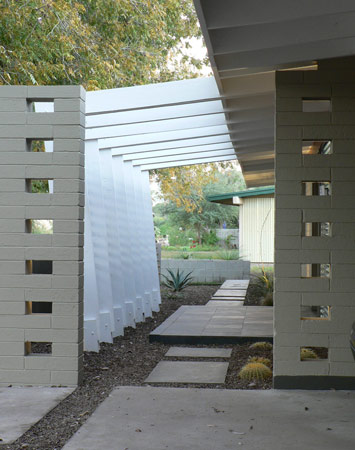
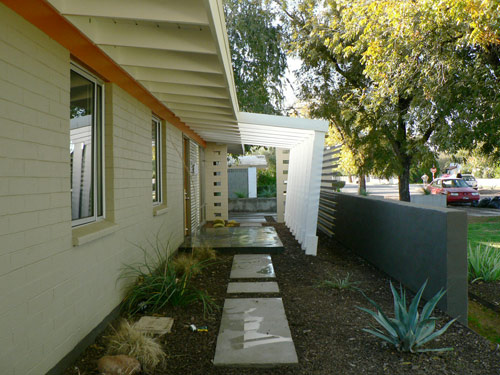 “God rest her soul, Lorna had stuccoed the entire house,” Kaffer recounted with a wry chuckle. “I couldn’t sandblast with the way the stucco was applied, so I was out there with a chisel for about a year and half.” The stucco was chipped away brick by brick with the resolve of Sisyphus to reveal the running bond of the original masonry.
“God rest her soul, Lorna had stuccoed the entire house,” Kaffer recounted with a wry chuckle. “I couldn’t sandblast with the way the stucco was applied, so I was out there with a chisel for about a year and half.” The stucco was chipped away brick by brick with the resolve of Sisyphus to reveal the running bond of the original masonry.
The reality of economic building was most evident here; the mortar and CMU block were sturdy, but too tender to hold up against sandblasting media. The result was worth it as earthy grays and flecks of black aggregate were revealed in the original block. By today’s standards, the home wasn’t so pretty, though it’s easy to understand why it was fashionable in its heyday. Lorna had already bumped the kitchen further back on the property decades ago, and had knocked down one of the bedroom walls to create a dining room.
A flashy Art Deco mural had been integrated into the remaining wall. The original materials palette included raised velvet wallpaper and deep ocean blue carpet throughout. It took a little x-ray vision to strip away all the surfaces and recognize the good bones beneath. 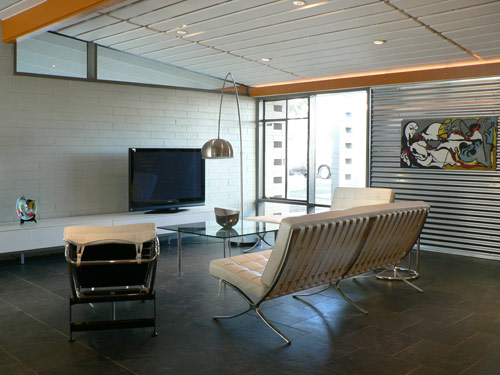 “Instantly I fell in love with it and said this is it!” Kaffer enthused. But what the Kaffers were after wasn’t exactly what they expected. When they first started their search they were already familiar with the Haver Homes of Marlen Grove in Uptown Phoenix.
“Instantly I fell in love with it and said this is it!” Kaffer enthused. But what the Kaffers were after wasn’t exactly what they expected. When they first started their search they were already familiar with the Haver Homes of Marlen Grove in Uptown Phoenix.
“I didn’t know much about Starlite Vista. The home that we went through in Marlen Grove–which was my first introduction to the style–had the exposed rafters, the beautiful clerestory windows and these great details. When we bought this house, it came with plaster ceilings and walls, so I thought all of those beams were hiding under the ceiling. The plan was to tear all that out and expose them so it would be just as good as Marlen Grove. I poked open a couple holes and that was not the case. The builders got a little more energy efficient, and they allowed air to transfer from eave to eave to pull the heat out. So I decided to be responsible and keep that. The rhythm was really what I was after, in the 50s style.”
So Kaffer’s solution was to create a new treatment for the ceilings. Similar to the ceiling slats used overhead on Haver’s Lou Regester (now Copenhagen) building on Camelback Road, Kaffer also used wooden slats to draw the eye upward and emphasize horizontal lines. Only Kaffer leaves space between each slat and dramatically backlights the ceiling along the main beams, creating a lattice of light, rhythm and texture overhead. The decking appears to penetrate from room to room, as one interior wall of the home has been given new clerestory windows that allow the upward gaze to travel beyond the room’s boundaries—just another trick used to make the modest floorplan feel much larger and lighter than it originally was.
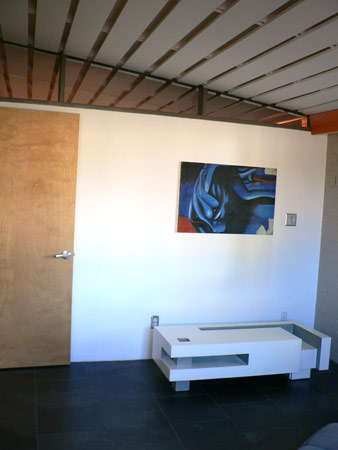
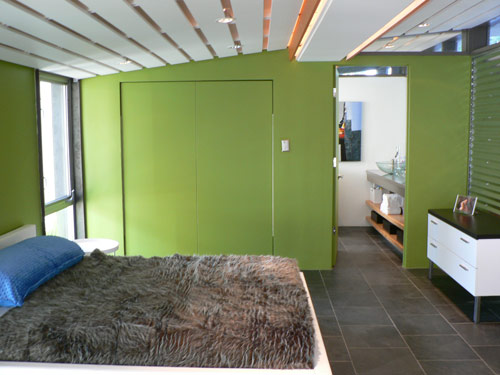
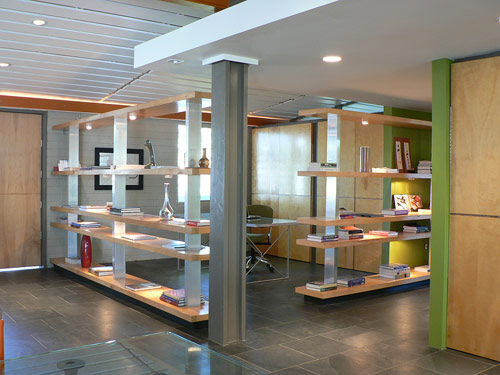 One problematic characteristic of Haver Homes and ranch homes in general is their tendency to sprawl along the x-axis. Once inside, there is often little structure left to draw visitors forward through the space. Kaffer amended the program by installing massive glass doors that sweep open to invite guests past an entertainer’s kitchen through three outdoor zones which act as an entirely new wing of the house.
One problematic characteristic of Haver Homes and ranch homes in general is their tendency to sprawl along the x-axis. Once inside, there is often little structure left to draw visitors forward through the space. Kaffer amended the program by installing massive glass doors that sweep open to invite guests past an entertainer’s kitchen through three outdoor zones which act as an entirely new wing of the house. 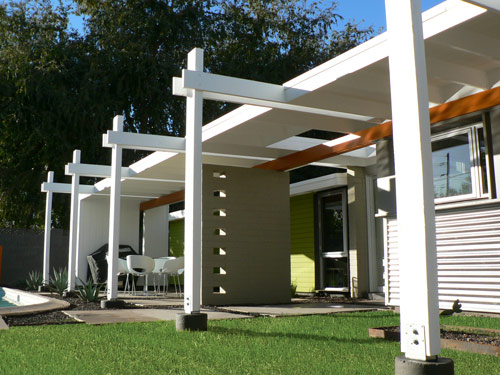 The roof rafters and existing walls in the home were extruded out into the back yard spaces. Carefully chosen rectangles similar to those found in Haver’s Town and Country home models are punched through the shade structure to frame Arizona’s famously blue sky like a living canvas. Haver’s original fenestrated block wall design was repeated several times by Kaffer to create visual and structural continuity.
The roof rafters and existing walls in the home were extruded out into the back yard spaces. Carefully chosen rectangles similar to those found in Haver’s Town and Country home models are punched through the shade structure to frame Arizona’s famously blue sky like a living canvas. Haver’s original fenestrated block wall design was repeated several times by Kaffer to create visual and structural continuity.
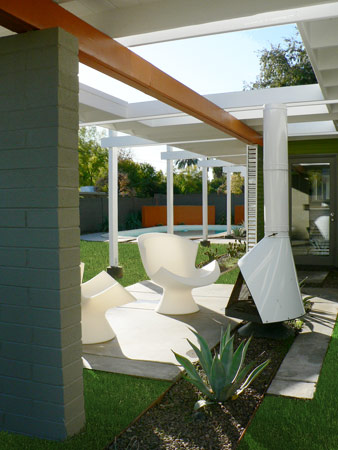 To the untrained eye it may be difficult to tell where Haver’s original structure ends and Kaffer’s new design begins. But for aficionados of Phoenix’s rehabilitated tract home genre, the Lorna House’s improvements are a bold improvisation on a jazz standard that evokes delight in both originality and ingenuity. Teasing the tunes apart is half the fun, but finding out where they fuse together is equally satisfying.
To the untrained eye it may be difficult to tell where Haver’s original structure ends and Kaffer’s new design begins. But for aficionados of Phoenix’s rehabilitated tract home genre, the Lorna House’s improvements are a bold improvisation on a jazz standard that evokes delight in both originality and ingenuity. Teasing the tunes apart is half the fun, but finding out where they fuse together is equally satisfying.

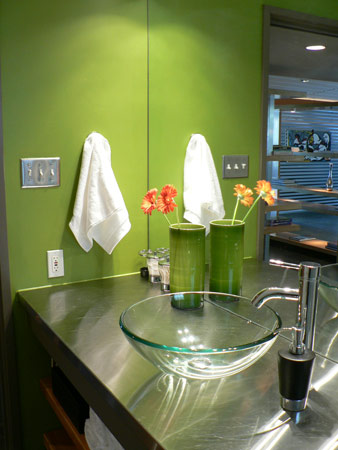

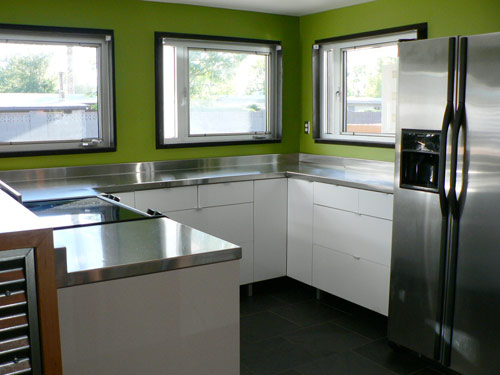

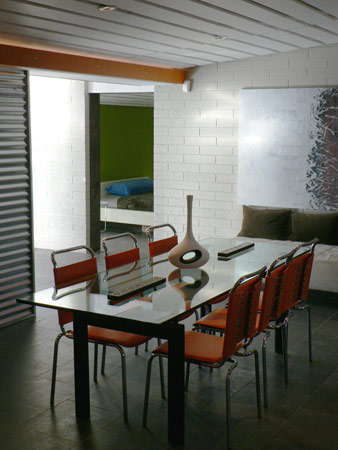
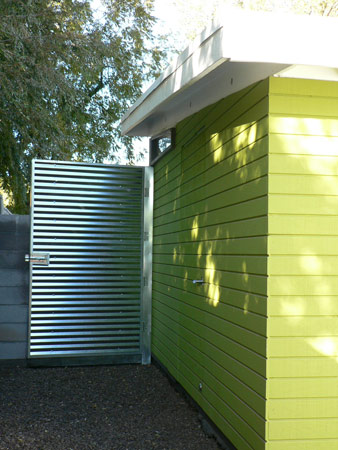
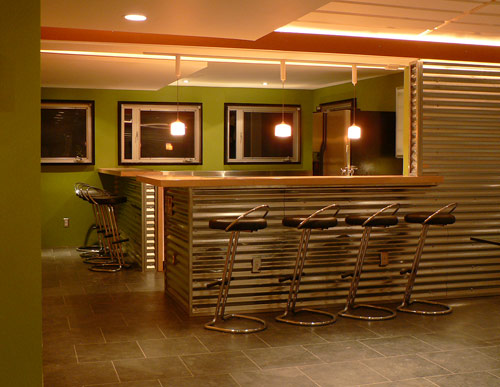
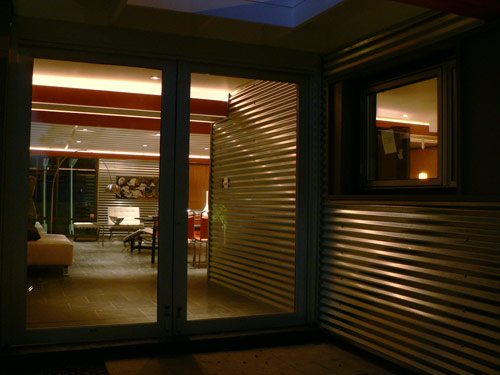
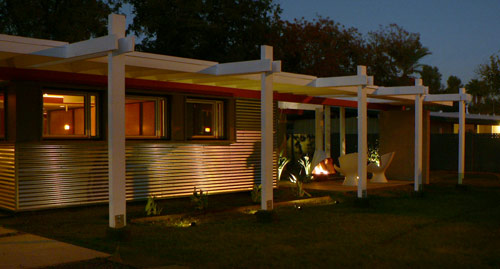
 Listen in as Desert Living Editor David Tyda takes a walk through the space with Alison King and Shawn Kaffer. [28 min. WAV file]
Listen in as Desert Living Editor David Tyda takes a walk through the space with Alison King and Shawn Kaffer. [28 min. WAV file]
Discuss Kaffer's project on our forums—in a conversation going on since 2004! Read from the start, or jump right into the new 2008 discussion.
View the home before it was renovated.